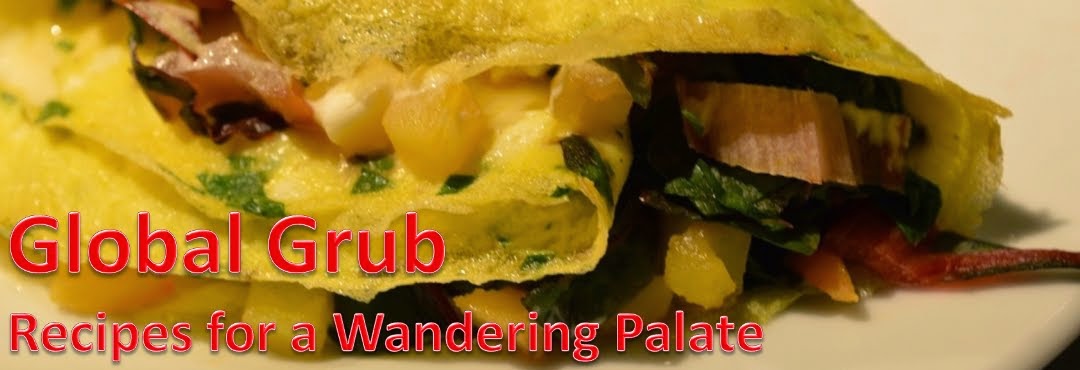I tend to stir-fry over any other form of cooking, because I like those flavors and the dishes come together quickly. I'm always on the lookout for new variations on my dishes, as well as simple recipes that make my stir-frying lifestyle a bit easier. So when I randomly stumbled on this recipe from Wegmans, I hung onto it to make one day. And a mere 6 years later, I finally checked it out. I'm not sure why I waited so long - it's great, not terribly difficult, and makes a mountain of food. Plus, I had never cooked with mushroom flavored soy sauce before, and any time I get to use a new ingredient is a good day.
 |
| You'll end up with about 4 servings, though I pass no judgment on how many people this will end up feeding :) |
This dish tastes similar to what you would get from any of the mongolian BBQ restaurants scattered around the country, but it's probably more healthy since you know what went into it, and probably also about a third of the cost. We went all out - NY strip instead of beef sirloin - but you could use the proposed cut of beef with great results. Also, my friends suggested adding some mushrooms next time, which I would probably add (in small quantities to avoid screwing up the cooking process) along with the meat.
For this recipe, I only modified the sequencing of the cooking process, and also removed store-branded products from the list to replace them with actual names. If you buy these ingredients from your average asian grocery store (and they are all commonly found there), you'll probably pay 25-50% of what you would pay at a standard American megamarket. And that assumes they would even have some of this stuff, such as mushroom-flavored soy and frozen udon. Don't bother being clever and substituting things like spaghetti or regular soy - it won't be the same experience.
Hong Kong-Style Beef with Udon Noodles
from Wegmans magazine
- 1 lb beef sirloin, sliced thinly across the grain
- 3 tbsp water
- 1 1/2 tbsp cornstarch
- 2 pkgs (6.98 oz each) frozen udon noodles, thawed
- 2 tbsp oyster sauce
- 1 tbsp mushroom flavored soy sauce
- 1 tbsp sugar
- 8 oz bean sprouts
- 1 bunch green onions, trimmed, cut in thin strips 2-2 1/2 inches long (about 1 cup)
- 2 tbsp vegetable oil
- 2 tbsp fresh ginger root, peeled, sliced thin
- 1/2 large onion, peeled, 1/4-inch slices (about 1 cup)
Place beef in small bowl. Add water, 1 tbsp at a time, working it in with your hands until the water is absorbed into beef. Sprinkle cornstarch over the beef and work in with your hands to coat all the pieces. You're doing this so that you get a nice crispy coating to the meat; it is not 100% necessary, but an interesting variant I've seen before, notably in many of P.F. Chang's beef dishes (their mongolian beef in particular - I have a recipe if anyone wants it).
Loosen the noodles by hand and set them aside.
Mix oyster sauce, soy sauce, and sugar in a small bowl, and set aside.
 |
| Here's all of the prepped ingredients. In retrospect, this recipe was slightly more involved than I expected |
Blanch the sprouts and green onion in large pot of boiling salted water 5 seconds; drain and set aside. Why? Because you're going to put them in at the very end of the cooking, and you want to take the bite out of the green onions without overcooking them. Is it a senseless waste of energy? Maybe, but you always follow the recipe the first time.
Heat your pan until it's as hot as it's going to get. Once the pan is heated, drizzle the oil around the sides of stir-fry pan, then immediately add the beef, ginger, and onion slices. Don't wait too long or you'll burn the oil - it's a temperature game (you want the pan rocket hot, the oil below 375 F so it won't oxidize and become toxic [and here's another, more scientific link from J. American Science], and the meat as hot as you can get it without burning the oil). Now stir-fry for 3-4 min. I did this in two batches, and you should too - don't crowd the pan!
 |
| Add the beef, but leave plenty of room so that you have enough heat to cook everything quickly. Better to do 2 batches correctly than screw everything up at once |
 |
| This is about as much as you should have in your pan. Any more and you won't be stir-frying, you'll be steaming / boiling while the meat gets dried out. |
 |
| This is half the batch. Notice the brown color on there, from the Maillard reaction. |
Add noodles; stir fry about 1 min. Add sauce; stir fry 30 seconds, until heated through. Try to fold rather than stirring, so you don't break up the noodles too much. Add sprouts and green onions to pan. Stir fry briefly to heat through and blend. Serve.
 |
| Toss the noodles together with the sauce and meat, and then add the sprouts and greens |
 |
| The finished udon noodles, served with chinese broccoli |





















